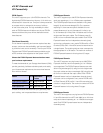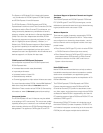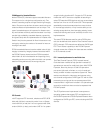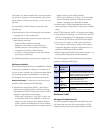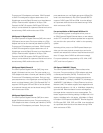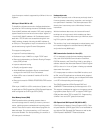There are two PCIe adapters per feature. OSA-Express3
10 GbE LR is designed to support attachment to a 10
Gigabits per second (Gbps) Ethernet Local Area Network
(LAN) or Ethernet switch capable of 10 Gbps. OSA-
Express3 10 GbE LR supports CHPID type OSD exclu-
sively. It can be defi ned as a spanned channel and can be
shared among LPARs within and across LCSSs.
OSA-Express3 10 Gigabit Ethernet SR
The OSA-Express3 10 Gigabit Ethernet (GbE) short reach
(SR) feature has two ports. Each port resides on a PCIe
adapter and has its own channel path identifi er (CHPID).
There are two PCIe adapters per feature. OSA-Express3
10 GbE SR is designed to support attachment to a 10
Gigabits per second (Gbps) Ethernet Local Area Network
(LAN) or Ethernet switch capable of 10 Gbps. OSA-
Express3 10 GbE SR supports CHPID type OSD exclu-
sively. It can be defi ned as a spanned channel and can be
shared among LPARs within and across LCSSs.
OSA-Express3 Gigabit Ethernet LX
The OSA-Express3 Gigabit Ethernet (GbE) long wave-
length (LX) feature has four ports. Two ports reside on a
PCIe adapter and share a channel path identifi er (CHPID).
There are two PCIe adapters per feature. Each port sup-
ports attachment to a one Gigabit per second (Gbps) Eth-
ernet Local Area Network (LAN). OSA-Express3 GbE LX
supports CHPID types OSD and OSN. It can be defi ned
as a spanned channel and can be shared among LPARs
within and across LCSSs.
OSA-Express3 Gigabit Ethernet SX
The OSA-Express3 Gigabit Ethernet (GbE) short wave-
length (SX) feature has four ports. Two ports reside on a
PCIe adapter and share a channel path identifi er (CHPID).
There are two PCIe adapters per feature. Each port sup-
ports attachment to a one Gigabit per second (Gbps) Eth-
ernet Local Area Network (LAN). OSA-Express3 GbE SX
supports CHPID types OSD and OSN. It can be defi ned
as a spanned channel and can be shared among LPARs
within and across LCSSs.
Four-port exploitation on OSA-Express3 GbE SX and LX
For the operating system to recognize all four ports on
an OSA-Express3 Gigabit Ethernet feature, a new release
and/or PTF is required. If software updates are not applied,
only two of the four ports will be “visible” to the operating
system.
Activating all four ports on an OSA-Express3 feature pro-
vides you with more physical connectivity to service the
network and reduces the number of required resources (I/O
slots, I/O cages, fewer CHPIDs to defi ne and manage).
Four-port exploitation is supported by z/OS, z/VM, z/VSE,
z/TPF, and Linux on System z.
OSA-Express3 1000BASE-T Ethernet
The OSA-Express3 1000BASE-T Ethernet feature has
four ports. Two ports reside on a PCIe adapter and share
a channel path identifi er (CHPID). There are two PCIe
adapters per feature. Each port supports attachment to
either a 10BASE-T (10 Mbps), 100BASE-TX (100 Mbps), or
1000BASE-T (1000 Mbps or 1 Gbps) Ethernet Local Area
Network (LAN). The feature supports auto-negotiation and
automatically adjusts to 10, 100, or 1000 Mbps, depending
upon the LAN. When the feature is set to autonegotiate,
the target device must also be set to autonegotiate. The
feature supports the following settings: 10 Mbps half or full
duplex, 100 Mbps half or full duplex, 1000 Mbps (1 Gbps)
full duplex. OSA-Express3 1000BASE-T Ethernet supports
CHPID types OSC, OSD, OSE, and OSN. It can be defi ned
as a spanned channel and can be shared among LPARs
within and across LCSSs.
27



